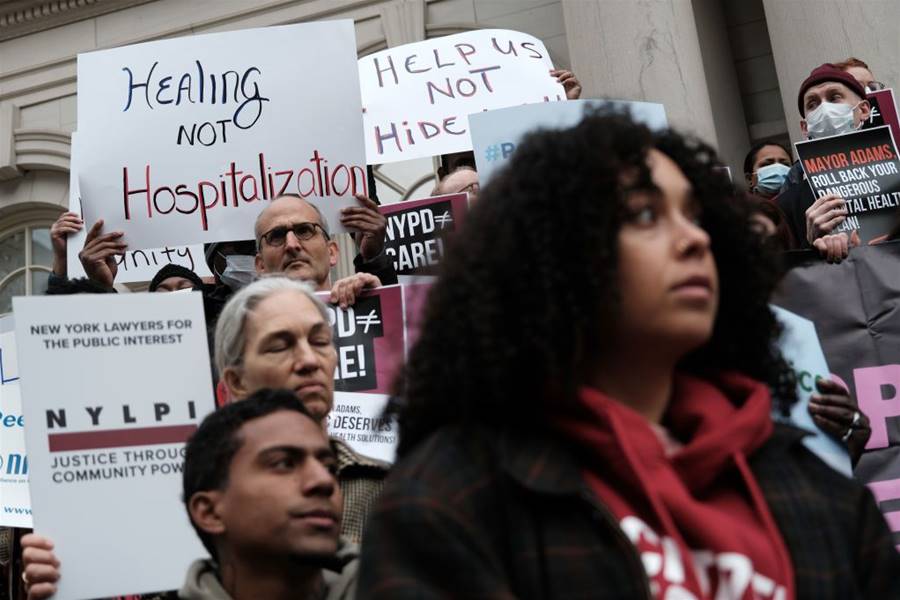

New York City Mayor Eric Adams has rolled out a plan to allow police officers and emergency workers to involuntarily hospitalize homeless people who are mentally ill. As of September, the Coalition for the Homeless reported there to be 60,252 homeless people in New York City. Advocates for the rights of homeless people and those with mental illness have spoken out against the new policy as removing basic human rights.
New York City Mayor Eric Adams an expansion in police and emergency workers’ ability to involuntarily remove presenting with mental health conditions and hospitalize them.
Currently, New York State law allows for people to be forcibly removed from the street if there is a potential for them to cause “serious harm” personally or to others.
The critiques came swiftly from leading civil liberties workers. “Unless we adequately invest in the long-term health and well-being of New Yorkers facing mental illness and our chronic lack of housing, the current mental health crisis will continue,” a from Donna Lieberman, the executive director of the New York Civil Liberties Union, read.
“The decades-old practice of sweeping deep-seated problems out of public view may play well for the politicians, but the problems will persist—for vulnerable people in desperate need of government services and for New Yorkers,” said Lieberman.
Matt Kudish, CEO of the National Alliance of Mental Illness - New York City Metro (NAMI-NYC), echoed these concerns in a : “The Administration’s expanded use of Kendra’s Law or assisted outpatient treatment (AOT) to people with SMI [severe mental illness] who ‘cannot meet their basic needs' is beyond problematic."
Kurdish continues, "AOT is a last resort mechanism, not a mental health response. People living with SMI have a right to person-centered and recovery-oriented mental health care. Instead of using the least restrictive approach, we are defaulting to an extreme that takes away basic human rights.
”
On Thursday, December 8, NAMI-NYC joined organizations, including , , and (CCIT-NYC).
New York is not the only place enforcing such policies with mixed reviews and results. Recently, three hospital systems sued Oregon state after people with mental illness were left in their care instead of moving them to long-term care. These individuals had been deemed a danger to themselves or others when admitted.
“Sometimes people are truly a danger to themselves—either in terms of active risk like suicide, or in terms of not meeting their basic survival needs, like not eating—or a danger to others, and hospitalization, with or without consent, is the only appropriate and ethical treatment,” says
, a psychiatrist, and director of Clinical Programs at . As of September 2022, there were 60,252 homeless people in New York City.
If the Mayor is serious about helping the homeless of New York City get housing, he will expand the use of an evidence-based model to deliver housing and mental health services to New York City’s homeless population.
— Irene Hurford, MD, a psychiatrist and director of Clinical Programs at One Mind
The policy sets forth training police officers to identify who needs mental health care.
Hurford calls this quick guidance and power to make these life-changing decisions a “recipe for violating human rights” and a potential for traumatizing impacted individuals.
, a psychiatrist with , points to a myriad of issues that can arise. People may not willingly want to leave, especially if they have delusions about being taken or have witnessed other individuals being involuntarily committed.
Tension and even violence can occur—a combination further heightened by . Since 2015, instances of an on-duty police officer shooting and killing someone, the victim had a mental illness, according to a database managed by The Washington Post.
There is the compounded issue of an overwhelmed hospital system and a tremendous lack of affordable housing in New York City. (or what affordable means in New York City) are rare. The vacancy rate for apartments under $900 is 0.86%, according to the . In contrast, the survey found 12.64% of apartments $2,300 and up to be vacant.
Mental health professionals across New York City have about the lack of psychiatric beds and staff to care for patients.
Experts agree: Creating more accessible (both in affordability and safety) housing and healthcare is a critical path forward.
“Without addressing the underlying housing problem and the lack of access to appropriate healthcare, we are simply perpetuating the problem,” says Khan.
“Mayor Adams has advanced a Housing First model, but at this time, it will only provide housing to a small minority of the homeless in New York City,” adds Hurford. “If the Mayor is serious about helping the homeless of New York City get housing, he will expand the use of an evidence-based model to deliver housing and mental health services to New York City’s homeless population.”
As stated, individuals with mental health concerns and homeless people both require help. This includes affordable and accessible housing and medical treatment. Experts in the field advocate for these steps to be taken in order to secure long-term, beneficial changes. As an individual, you can advocate for these steps and work to create a fair, equal place for all.
